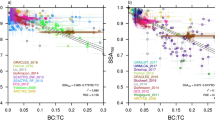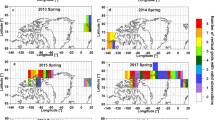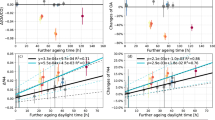Abstract
Carbonaceous aerosols affect the global radiative balance by absorbing and scattering radiation, which leads to warming or cooling of the atmosphere, respectively. Black carbon is the main light-absorbing component. A portion of the organic aerosol known as brown carbon also absorbs light. The climate sensitivity to absorbing aerosols rapidly increases with altitude, but brown carbon measurements are limited in the upper troposphere. Here we present aircraft observations of vertical aerosol distributions over the continental United States in May and June 2012 to show that light-absorbing brown carbon is prevalent in the troposphere, and absorbs more short-wavelength radiation than black carbon at altitudes between 5 and 12 km. We find that brown carbon is transported to these altitudes by deep convection, and that in-cloud heterogeneous processing may produce brown carbon. Radiative transfer calculations suggest that brown carbon accounts for about 24% of combined black and brown carbon warming effect at the tropopause. Roughly two-thirds of the estimated brown carbon forcing occurs above 5 km, although most brown carbon is found below 5 km. The highest radiative absorption occurred during an event that ingested a wildfire plume. We conclude that high-altitude brown carbon from biomass burning is an unappreciated component of climate forcing.
This is a preview of subscription content, access via your institution
Access options
Access Nature and 54 other Nature Portfolio journals
Get Nature+, our best-value online-access subscription
$29.99 / 30 days
cancel any time
Subscribe to this journal
Receive 12 print issues and online access
$259.00 per year
only $21.58 per issue
Buy this article
- Purchase on Springer Link
- Instant access to full article PDF
Prices may be subject to local taxes which are calculated during checkout



Similar content being viewed by others
References
Myhre, G. et al. in Climate Change 2013: The Physical Science Basis (eds Stocker, T. F. et al.) 659–740 (IPCC, Cambridge Univ. Press, 2013).
Kirchstetter, T. W., Novakov, T. & Hobbs, P. V. Evidence that the spectral dependence of light absorption by aerosols is affected by organic carbon. J. Geophys. Res. 109, D21208 (2004).
Alexander, D. T. L., Crozier, P. A. & Anderson, J. R. Brown carbon spheres in East Asian outflow and their optical properties. Science 321, 833–836 (2008).
Saleh, R. et al. Brownness of organics in aerosols from biomass burning linked to their black carbon content. Nat. Geosci. 7, 647–650 (2014).
Zhang, X. et al. Light-absorbing soluble organic aerosol in Los Angeles and Atlanta: a contrast in secondary organic aerosol. Geophys. Res. Lett. 38, L21810 (2011).
Kirchstetter, T. W. & Thatcher, T. L. Contribution of organic carbon to wood smoke particulate matter absorption of solar radiation. Atmos. Chem. Phys. 12, 6067–6072 (2012).
Liu, X. et al. Agricultural fires in the southeastern US during SEAC4RS: emissions of trace gases and particles and evolution of ozone, reactive nitrogen, and organic aerosol. J. Geophys. Res. 121, 7383–7414 (2016).
Hecobian, A. et al. Water-Soluble Organic Aerosol material and the light-absorption characteristics of aqueous extracts measured over the Southeastern United States. Atmos. Chem. Phys. 10, 5965–5977 (2010).
Liu, J. et al. Size-resolved measurements of brown carbon in water and methanol extracts and estimates of their contribution to ambient fine-particle light absorption. Atmos. Chem. Phys. 13, 12389–12404 (2013).
Liu, J. et al. Brown carbon in the continental troposphere. Geophys. Res. Lett. 41, 2191–2195 (2014).
Liu, J. et al. Brown carbon aerosol in the North American continental troposphere: sources, abundance, and radiative forcing. Atmos. Chem. Phys. 15, 7841–7858 (2015).
Forrister, H. et al. Evolution of brown carbon in wildfire plumes. Geophys. Res. Lett. 42, 4623–4630 (2015).
Arola, A. et al. Inferring absorbing organic carbon content from AERONET data. Atmos. Chem. Phys. 11, 215–225 (2011).
Chung, C. E., Ramanathan, V. & Decremer, D. Observationally constrained estimates of carbonaceous aerosol radiative forcing. Proc. Natl Acad. Sci. USA 109, 11624–11629 (2012).
Wang, X. et al. Deriving brown carbon from multi-wavelength absorption measurements: method and application to AERONET and surface observations. Atmos. Chem. Phys. Discuss. 2016, 1–33 (2016).
Feng, Y., Ramanathan, V. & Kotamarthi, V. R. Brown carbon: a significant atmospheric absorber of solar radiation? Atmos. Chem. Phys. 13, 8607–8621 (2013).
Wang, X. et al. Exploiting simultaneous observational constraints on mass and absorption to estimate the global direct radiative forcing of black carbon and brown carbon. Atmos. Chem. Phys. 14, 10989–11010 (2014).
Jo, D. S., Park, R. J., Lee, S., Kim, S. W. & Zhang, X. A global simulation of brown carbon: implications for photochemistry and direct radiative effect. Atmos. Chem. Phys. 16, 3413–3432 (2016).
Saleh, R. et al. Contribution of brown carbon and lensing to the direct radiative effect of carbonaceous aerosols from biomass and biofuel burning emissions. J. Geophys. Res. 120, 10285–10296 (2015).
Hodnebrog, Ø, Myhre, G. & Samset, B. H. How shorter black carbon lifetime alters its climate effect. Nat. Commun. 5, 5065 (2014).
Ban-Weiss, G. A., Cao, L., Bala, G. & Caldeira, K. Dependence of climate forcing and response on the altitude of black carbon aerosols. Clim. Dynam. 38, 897–911 (2012).
Koch, D. & Del Genio, A. D. Black carbon semi-direct effects on cloud cover: review and synthesis. Atmos. Chem. Phys. 10, 7685–7696 (2010).
Barth, M. C. et al. The deep convective clouds and chemistry (DC3) field campaign. Bull. Am. Meteorol. Soc. 96, 1281–1309 (2015).
Toon, O. B. et al. Planning, implementation, and scientific goals of the Studies of Emissions and Atmospheric Composition, Clouds and Climate Coupling by Regional Surveys (SEAC4RS) field mission. J. Geophys. Res. 121, 4967–5009 (2016).
Corr, C. A. et al. Observational evidence for the convective transport of dust over the central United States. J. Geophys. Res. 121, 1306–1319 (2016).
Desyaterik, Y. et al. Speciation of “brown” carbon in cloud water impacted by agricultural biomass burning in eastern China. J. Geophys. Res. 118, 7389–7399 (2013).
Gilardoni, S. et al. Direct observation of aqueous secondary organic aerosol from biomass-burning emissions. Proc. Natl Acad. Sci. USA 113, 10013–10018 (2016).
Laskin, A., Laskin, J. & Nizkorodov, S. A. Chemistry of atmospheric brown carbon. Chem. Rev. 115, 4335–4382 (2015).
Koch, D. et al. Evaluation of black carbon estimations in global aerosol models. Atmos. Chem. Phys. 9, 9001–9026 (2009).
Liu, Y., Stanturf, J. & Goodrick, S. Trends in global wildfire potential in a changing climate. For. Ecol. Manage. 259, 685–697 (2010).
Washenfelder, R. A. et al. Biomass burning dominates brown carbon absorption in the rural southeastern United States. Geophys. Res. Lett. 42, 653–664 (2015).
Schwarz, J. P. et al. Aircraft measurements of black carbon vertical profiles show upper tropospheric variability and stability. Geophys. Res. Lett. 44, 1132–1140 (2017).
DeCarlo, P. F. et al. Field-deployable, high-resolution, time-of-flight aerosol mass spectrometer. Anal. Chem. 78, 8281–8289 (2006).
Bond, T. C., Anderson, T. L. & Campbell, D. Calibration and intercomparison of filter-based measurements of visible light absorption by aerosols. Aerosol Sci. Technol. 30, 582–600 (1999).
Virkkula, A. Correction of the calibration of the 3-wavelength particle soot absorption photometer (3λ PSAP). Aerosol Sci. Technol. 44, 706–712 (2010).
Anderson, T. L. & Ogren, J. A. Determining aerosol radiative properties using the TSI 3563 integrating nephelometer. Aerosol Sci. Technol. 29, 57–69 (1998).
Bela, M. M. et al. Wet scavenging of soluble gases in DC3 deep convective storms using WRF-Chem simulations and aircraft observations. J. Geophys. Res. 121, 4233–4242 (2016).
Barth, M. C. et al. Convective transport and scavenging of peroxides by thunderstorms observed over the central US during DC3. J. Geophys. Res. 121, 4272–4295 (2016).
Ricchiazzi, P., Yang, S., Gautier, C. & Sowle, D. SBDART: a research and teaching software tool for plane-parallel radiative transfer in the earth’s atmosphere. Bull. Am. Meteorol. Soc. 79, 2101–2114 (1998).
Olson, M. R. et al. Investigation of black and brown carbon multiple-wavelength-dependent light absorption from biomass and fossil fuel combustion source emissions. J. Geophys. Res. 120, 6682–6697 (2015).
Bond, T. C. & Bergstrom, R. W. Light absorption by carbonaceous particles: an investigative review. Aerosol Sci. Technol. 40, 27–67 (2006).
Zarzycki, C. M. & Bond, T. C. How much can the vertical distribution of black carbon affect its global direct radiative forcing? Geophys. Res. Lett. 37, L20807 (2010).
Jethva, H., Torres, O. & Ahn, C. Global assessment of OMI aerosol single-scattering albedo using ground-based AERONET inversion. J. Geophys. Res. 119, 9020–9040 (2014).
Jethva, H. & Torres, O. Satellite-based evidence of wavelength-dependent aerosol absorption in biomass burning smoke inferred from Ozone Monitoring Instrument. Atmos. Chem. Phys. 11, 10541–10551 (2011).
Torres, O. et al. Aerosols and surface UV products from Ozone Monitoring Instrument observations: an overview. J. Geophys. Res. 112, D24S47 (2007).
Acknowledgements
All data used in this paper were collected as part of the NASA DC3 and SEAC4RS missions and became available to the general public on 15 October 2014 through the NASA data archive. Georgia Tech researchers were funded through NASA Radiation Sciences Program grant NNX14AP74G. NASA Tropospheric Composition Program supported J.D. through grant NNX12AB80G, and P.C.-J. and J.L.J. through grants NNX12AC03G and NNX15AT96G. H.F. was supported by the National Science Foundation Graduate Research Fellowship under Grant No. DGE-1650044. The authors thank G. Chen and C. Corr for discussion with Y.Z.
Author information
Authors and Affiliations
Contributions
Y.Z., Y.W., A.N. and R.J.W. designed the study. Y.Z. performed the analysis and calculation. J.L., J.D., B.A., J.P.S., A.E.P., J.L.J., P.C.-J. and R.J.W. conducted and analysed the aircraft measurements. Y.Z., H.F., Y.W., A.N. and R.J.W. discussed the results. Y.Z., Y.W., A.N. and R.J.W. wrote the paper. J.L.J., J.L., H.F., J.D. and J.P.S. provided input on the paper for revision before submission.
Corresponding author
Ethics declarations
Competing interests
The authors declare no competing financial interests.
Supplementary information
Supplementary Information
Supplementary Information (PDF 785 kb)
Rights and permissions
About this article
Cite this article
Zhang, Y., Forrister, H., Liu, J. et al. Top-of-atmosphere radiative forcing affected by brown carbon in the upper troposphere. Nature Geosci 10, 486–489 (2017). https://doi.org/10.1038/ngeo2960
Received:
Accepted:
Published:
Issue Date:
DOI: https://doi.org/10.1038/ngeo2960
This article is cited by
-
Combined influences of sources and atmospheric bleaching on light absorption of water-soluble brown carbon aerosols
npj Climate and Atmospheric Science (2023)
-
Shortwave absorption by wildfire smoke dominated by dark brown carbon
Nature Geoscience (2023)
-
More water-soluble brown carbon after the residential “coal-to-gas” conversion measure in urban Beijing
npj Climate and Atmospheric Science (2023)
-
Measurements of optical properties of black and brown carbon using multi-wavelength absorption technique at Mumbai, India
Journal of Earth System Science (2022)
-
Characterization of carbonaceous aerosols during the Indian summer monsoon over a rain-shadow region
Air Quality, Atmosphere & Health (2022)



